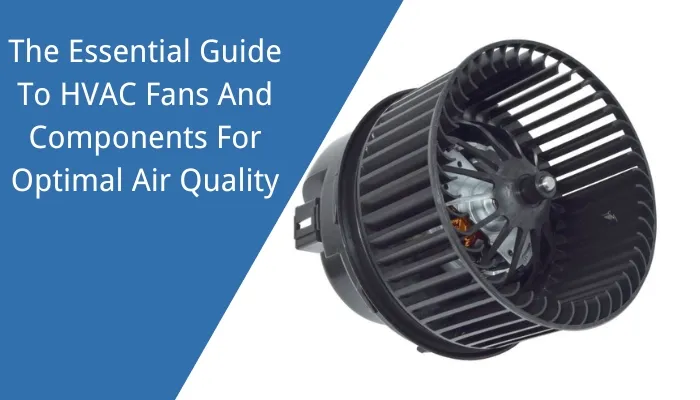
In this modern age, where indoor air quality has become a vital concern, grasping the parts of central air HVAC (Heating, Ventilation, and Cooling) frameworks is significant. At the core of these frameworks are air conditioning or HVAC fans, which are fundamental in keeping up with ideal air flow and guaranteeing a healthy climate.
HVAC fans significantly improve air quality, energy efficiency, and overall comfort in residential homes, commercial buildings, and industrial settings. This guide will provide detailed information about the different kinds of HVAC fans, their parts’ significance, and best practices for optimal performance and maintenance. By acquiring an exhaustive comprehension of these components, homeowners and office directors can pursue informed choices to improve indoor air quality and framework execution.
Table of Contents
ToggleUnderstanding HVAC Fan Systems
An HVAC system, short for Warming, Ventilation, and Cooling, is an innovation intended to give thermal solace and satisfactory indoor air quality. So, central air frameworks are fundamental in private and business settings. As they direct the building structures’ temperature, humidity, and air quality. How about we separate the essential parts and elements of a central air framework:
Heating Components
So, this part is responsible for heating indoor air. And normal heating frameworks incorporate heaters, boilers, and heat pumps or siphons. Plus, boilers heat water to heat radiators or underfloor heating. Whereas furnaces typically use electricity or natural gas to generate heat. Hereafter, heat boilers can both heat and cool air by moving heat starting with one spot onto the next.
Ventilation Components
Also, ventilation includes the trading of indoor and outdoor to guarantee great air quality. Plus, it incorporates the expulsion of toxins, moisture, and odor from indoor air and brings fresh air form outside air. Moreover, ventilation frameworks can be normal, depending on windows and vents. Or mechanical, utilizing fans and pipes to control wind current.
Air Conditioning Components
This part cools the indoor air to give comfort during warm climates. Cooling frameworks work by eliminating heat from the indoor air and moving it outside. Two common types are window units or split systems, designed for specific rooms or areas, and central air conditioners, which cool entire buildings.
Types of HVAC Systems
So, HVAC frameworks come in different types and configurations. Each intended to address particular issues and inclinations. Therefore, the primary types of HVAC systems are as follows:
Split Systems
The majority of HVAC systems used in residential settings are split systems. They comprise of two fundamental units: an outside unit and an indoor unit.
Outdoor Unit: This unit contains the condenser and blower, which cooperate to deliver heat outside the structure.
Indoor Unit: This unit regularly houses the evaporator loop and an air controller, which flow and cool the air inside the building structure.
Packaged Systems
Packaged frameworks are air conditioning units that house all parts in a single cabinet, regularly put outside the structure or on the rooftop.
Single Unit: Also, contains the blower, condenser, evaporator, and air controller.
Types: So, they can be cooled by water or air and have heating parts like electric heating coils or furnaces that burn natural gas.
Ductless Systems
Ductless frameworks, or little divided frameworks, comprise an outdoor unit associated with at least one indoor unit without the requirement for ventilation work.
Open air Unit: Plus, contains the blower and condenser.
Indoor Units: Moreover, mounted on walls or roofs, each with its air handler.
Central Air Systems
Central air frameworks are intended to cool enormous spaces. By disseminating cooled air throughout the pipes network.
- Parts: Ordinarily incorporate an outside unit (condenser and compressor/blower) and an indoor unit (evaporator coil and air handler) connected via ductwork.
- Operation Activity: Plus, cools air in the evaporator coil and appropriates it through ducts to different rooms.
Types of HVAC Fans
In HVAC (heating, Ventilation, and Cooling) frameworks, different fans and blowers are used to move air through the framework for warming, cooling, and ventilation purposes. Here is a thorough outline of the normal kinds:
Axial Fan
Axial fans push air in parallel direction directions as the fan blades. So, they are intended to deal with huge volumes of air at low strain.
- Applications: Normally utilized in cooling towers, exhaust applications, and ventilation frameworks.
- Attributes: High wind current, low tension, somewhat loud & noisy, and energy-productive for specific applications.
Centrifugal Fans
Divergent fans, also called radial fans, move air in the opposite direction or axis to the fan. And they utilize an alternating impeller to expand the speed of an air stream and convert it to pressure.
- Applications: Ordinarily utilized in ventilation work, central air frameworks, and modern applications.
- Attributes: Also, higher strain, quieter operation, moderate to high wind stream, more productive in ducted frameworks.
Cross Flow Fans
The blades of cross-flow fans are long and narrow and have a cylinder shape. And air enters the fan, goes through the impeller, and ways out at a 90-degree point.
- Applications: Plus, utilized in air draperies, convectors, and cooling electronic hardware.
- Qualities: And, uniform wind stream dispersion, low profile, reasonable for explicit applications requiring a wide, uniform air dissemination.
Blowers
- Centrifugal Blowers: However, they regularly produce higher strain and are utilized to move air or gas. Kinds of Blowers: Divergent Blowers: Like outward fans, utilized in applications requiring high strain.
- Applications: plus, use in central air frameworks, modern cycles, air contamination control frameworks.
- Qualities: Also, High tension, moderate wind stream, proficient for ducted frameworks.
- Positive Displacement Blowers:
Move a decent volume of air or gas with every turn.
- Applications: Plus pneumatic conveying, air circulation, modern vacuum frameworks.
- Qualities: And high tension, lower wind current contrasted with divergent blowers, steady volume yield.
Key Components of HVAC Fans
Here is a breakdown of the critical parts of central air fans and their capabilities:
- Fan Blades
So, these turning airfoils produce wind current inside the air conditioning framework. Plus, the plan of the edges decides how much air moved (CFM – Cubic Feet each Moment) and the static strain produced.
- Motors
Plus, the engine gives the ability to pivot the fan edges. Engines in central air frameworks can be PSC (Permanent Split Capacitor), ECM (Electronically Commutated Engine), or brushless DC engines. And the sort of engine picked relies upon the particular necessities of the framework. Like proficiency, wind stream prerequisites, and commotion levels.
- Fan Housing
The housing encases the fan’s sharp edges and engine. Which giving a smoothed-out construction to productive wind stream and shielding the pivoting parts from flotsam and jetsam. So, sheet metal is the most common material for housings. And it can be designed with forward-, backward-, or airfoil blade configurations.
- Bearings
Heading supports the alternating shaft of the engine and fan edge get together, considering smooth rotation with low friction. Moreover, metal balls are typical in air conditioning fans. As they offer a decent equilibrium of execution, toughness, and cost.
- Dampers and Louvers
Moreover, dampers and louvres are flexible air control gadgets that manage the wind current inside the air conditioning framework. And dampers are commonly situated inside the ventilation work, while louvres are often found on exhaust vents. So, they can be physically or naturally changed by controlling the wind stream’s volume, course, and tension.
Selecting the Right HVAC Fans for Your System
If you want to keep your heating and cooling system running at its best and make you feel comfortable, you must get the right HVAC fan. When choosing a fan, you need to consider the following factors:
- Size and Capacity
So, knowing the aspects (breadth and width) of your ongoing fan will assist you with tracking down a viable substitution. Therefore, think about CFM (Cubic Feet each Moment): This alludes to the volume of air the fan can move. Higher CFM is required for bigger spaces or high-static strain circumstances (long conduit runs with many elbows). Counsel your air conditioning framework manual or an expert for proposals on the fitting CFM rating.
- Airflow Requirements
Therefore, we can expect this tension to beat resistance in the ventilation work. Plus, factors like duct size, length, and number of twists influence static strain. And a fan with sufficient static pressure is required to ensure sufficient airflow throughout the duct system.
- Energy Efficiency
So, search for fans with high CFM per watt appraisals. And this shows the fan’s capacity to move more air with less energy utilization. Regarding engine type, ECM (Electronically Commutated Engine) and brushless DC engines are mostly more energy-proficient than PSC (Extremely durable Split Capacitor) engines.
- Noise Levels
Further, design of fan blade and engine type impact noise levels. For quieter operation, look for fans with lower noise ratings and a unit of loudness. Like tsl offering high quality fans.
- Compatibility with Existing Systems
And guarantee the new fan’s aspects (distance across, width, and mounting focuses) match your current framework. Plus check the voltage and amperage necessities of the new fan match your framework’s electrical stock.
Conclusion
Overall, HVAC air fans and their parts are essential to accomplishing and keeping up with ideal air quality. So, the proper selection, installation, and maintenance of HVAC systems ensure they function effectively and provide clean and comfortable indoor environments. And grasping the different sorts of fans, from centrifugal to axial, and the jobs of parts like engines, cutting edges, and dampers enables clients to upgrade their HVAC system. So, one can improve air quality and energy effectiveness by focusing on regular maintenance and remaining informed about the most recent technologies.
